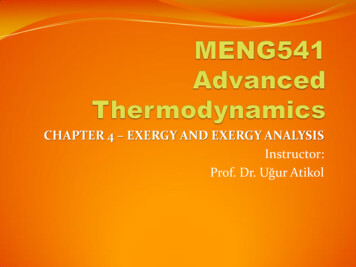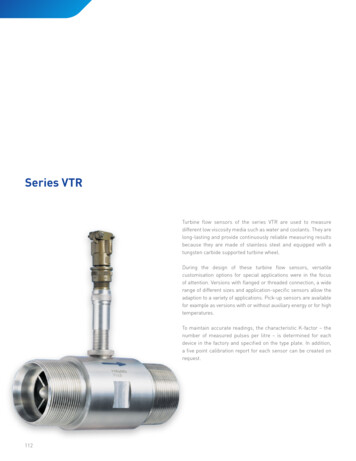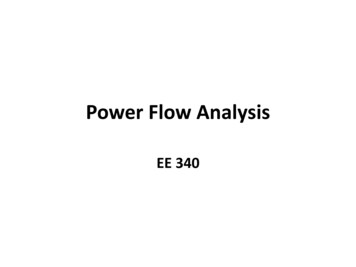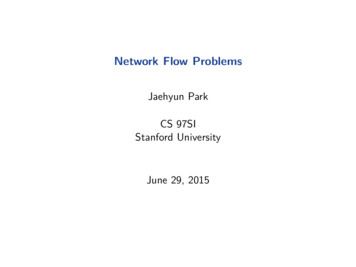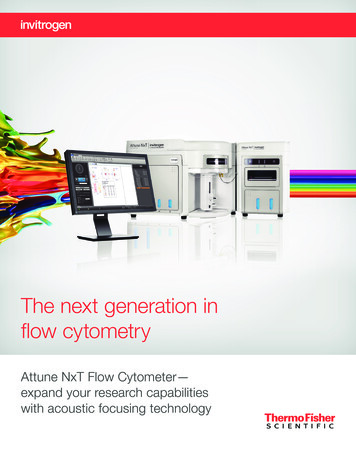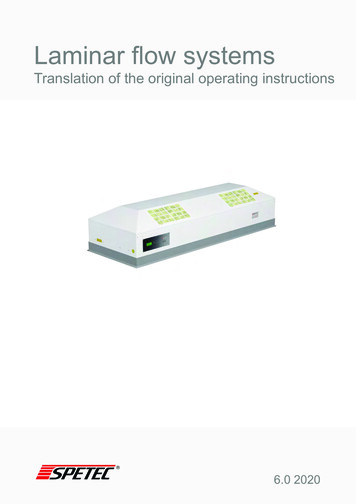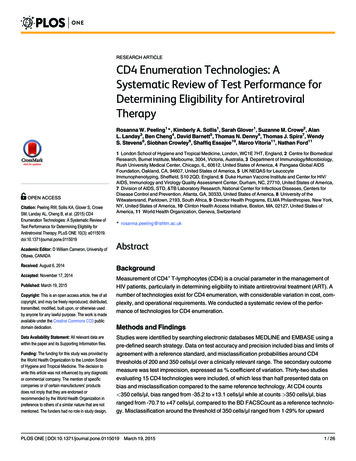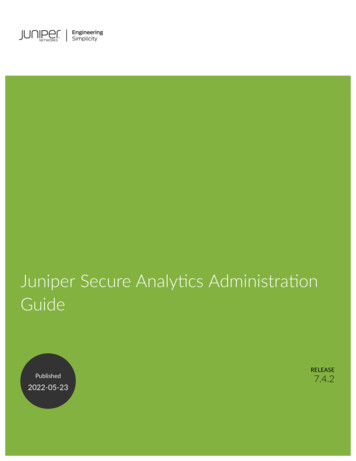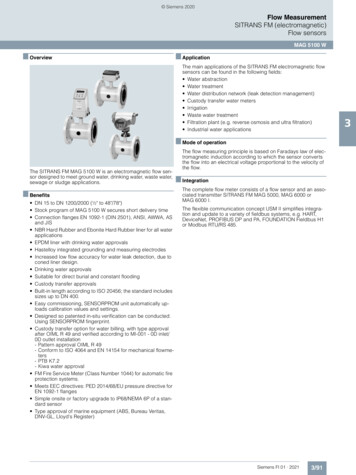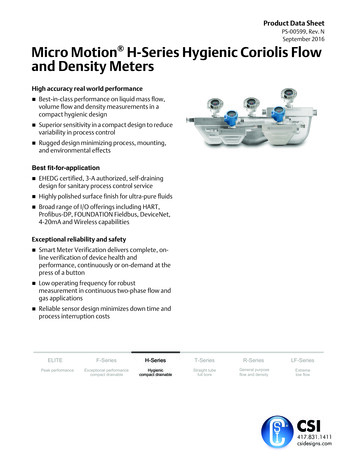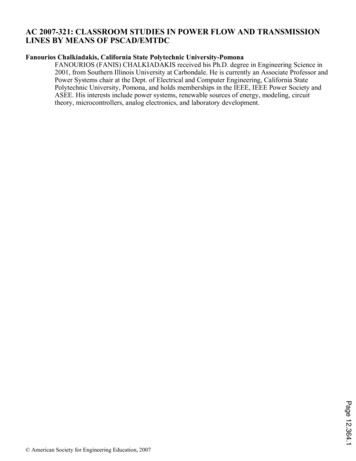
Transcription
AC 2007-321: CLASSROOM STUDIES IN POWER FLOW AND TRANSMISSIONLINES BY MEANS OF PSCAD/EMTDCFanourios Chalkiadakis, California State Polytechnic University-PomonaFANOURIOS (FANIS) CHALKIADAKIS received his Ph.D. degree in Engineering Science in2001, from Southern Illinois University at Carbondale. He is currently an Associate Professor andPower Systems chair at the Dept. of Electrical and Computer Engineering, California StatePolytechnic University, Pomona, and holds memberships in the IEEE, IEEE Power Society andASEE. His interests include power systems, renewable sources of energy, modeling, circuittheory, microcontrollers, analog electronics, and laboratory development.Page 12.364.1 American Society for Engineering Education, 2007
Classroom Studies in Power Flow and Transmission Linesby means of PSCAD/EMTDC1. IntroductionClassroom studies by means of software tools are a major part of the senior-level courserequirements of any electrical engineering program that offers majors in power systems. Studentinterest and enrollment however were in decline in this area until recently1, due to the limitednumber of available positions in the related industry and the erroneous impression that electricpower had narrow future for new developments compared to the impressive achievements inother fields of electrical engineering. This trend is changing and it is expected to continue tochange for the next five to ten years because of anticipated retirements and increased demand ofelectrical engineers in the power systems and renewable energy fields2.The power systems major in the department of Electrical and Computer Engineering (ECE) iscurrently under reconstruction as a result of increased student enrollment and availability ofpositions in the local power utility industry. Curriculum changes and new courses in renewableenergy, electric drives, power systems protection and a review of the introductory course inpower engineering are ongoing projects. It is anticipated that all these changes and improvementswill be completed in the near future.This ongoing process requires the utilization of software and hardware tools in order to educatethe students that choose power systems as their area of concentration. Hardware is traditionallymore expensive to acquire because of limited funding sources. Software on the other hand allowsthe students to study even at times when the hardware laboratory facilities are not operational,since computer-based laboratories do not usually require constant supervision. In particular, ourfaculty employs software that is used by professionals and research centers nationwide, and thusthe students are given the opportunity to familiarize themselves with the operation of toolssimilar to those that most likely they will have to use after they join the workforce.Demonstration of advanced concepts during regular class lectures in the courses of Introductionto Power Engineering (IPE), Power Electronics (PE), and Power Systems I and II (PS I/II) isanother area where software tools are frequently used in the ECE program. This tread developedbecause of the aging laboratory equipment, the limited funding for extensive hardware upgrades,and the fact that students seem to comprehend theory easier by means of multimedia tools.2. Power Systems StudiesPage 12.364.2The majority of power systems courses require a decent background in mathematics. Hence, aheavy load of studying time is required by every student who is enrolled in a power class, evenwhen the material is introductory. The PS I and II are no exception to that rule. In fact this wasone of the reasons that employment of advanced software was deemed necessary. Conventionalmethods of determining certain parameters of a power system are still taught in power classes;the ECE faculty however offers additional training to the students by means of PSCAD/EMTDC,a software simulation package distributed by the Manitoba HVDC Research Center in Canada3.
This real-time simulation software offers a very innovative user interface and an extended libraryof components ranging from simple passive elements and current/voltage sources to three-phaseinverter blocks, various electric machines, transformers, transmission lines, breakers, powersemiconductors and many control modules. Due to its real-time capabilities, faults and otherdisturbances can be simulated with virtual “buttons” and “switches” that can open and close atwill or by means of timers. It also permits the user to build new components, including blockslike counters, registers and digital signal comparators. In the background this software packageemploys state equations and a FORTRAN compiler in order to solve circuits from a few nodes tohundreds of nodes.PSCAD is introduced in the second week of the PS I class and training starts with two basicsessions. Examples are taken from the IPE class and used as case studies. This practice allowsthe students to familiarize with the solution of simple circuits that eventually become morecomplex. It has been observed that the students find the relatively difficult material of the PS Iand II classes more appealing when they use this simulation tool, since it allows them to betterunderstand and actually perceive how a circuit functions. In addition the instructors have theability to offer demonstrations of special setups and system configurations that would otherwisebe impossible to perform, considering the extremely high cost of a real life system that can besimulated with a relatively inexpensive software tool.The next step involves the assignment of problems similar to the ones solved in class in order tohelp the students develop their skills in a progressive manner. Subsequently, problems of addedcomplexity are assigned that require preliminary calculations and more study time before theactual simulation takes place. Occasionally, the verification of a solution with a second method isrequested. This technique allows for an in depth understanding of how all the different methodsof approaching a problem can be incorporated into one solution. Hence, flexibility and varietybecome additional parameters that students must consider in a software vs. conventional solutionsituation that often appears in real life cases.3. Case StudiesTwo case studies will be presented in this paper. The first case shows the simulation results of athree-bus system that allows for independent control of voltage and phase on each bus in a waythat clearly illustrates the principles of power flow control. The second case describes the designof a three-phase 13 kV overhead transmission line. This example is first solved in a conventionalway and then the results are verified by means of a simulation that takes into consideration thephysical characteristics of the line and the configuration of its conductors.3.1 Power Flow StudyPage 12.364.3Figure 1 shows the circuit diagram of the simulated system. Each three-phase source represents abus of a different power subsystem. All the subsystems are connected to each other via shortlength transmission lines that are shown only as inductive elements for simplicity4. The powermeters measure the power that exits the bus. In the diagram they appear as if they measure thepower across a three-phase element but this is how PSCAD calculates real and reactive powerthat flows from one point to another3. The meters show positive values when power is generated
Figure 1. Flow control of a three-bus power system.at a bus and negative values when power is absorbed by the bus. The voltage and phase of eachbus can be adjusted manually in order to control the flow of real and reactive power.This simulation is based on the generic principle that real power flows from a bus with a highphase angle to a bus with a lower phase angle, and reactive power flows from a bus with a highvoltage to a bus with a lower voltage4, 5. The voltage source on the left “acts” as the swing bus.Its voltage stays fixed at 33.6 kV (or 1 per unit) while its phase is set to zero degrees4, 5. Theoperating frequency of the network is 60 Hertz. Three cases are shown in order to demonstratethe principle described herein.There is very little chance that the setup shown in Figure 2 will occur in real life where all thebus voltages are the same while the phase angles are not. The results of the simulation show thatbus 1 supplies 8.7 MW of real power and buses 2 and 3 absorb 7 MW and 1.7 MW respectively.Most of the real power flows between the buses with the higher phase difference. There are alsoexchanges of reactive power among these buses due to the inductive elements of the “lines” andthe “generators” that are required by the simulation program.Page 12.364.4Figure 3 shows another unusual situation where all the phases are set to zero while the voltagesare different. It can be observed that the exchanges of real power are very small compared to the
Figure 2. Voltages and phase angles of the three-bus power system.flow of reactive power which appears to take place from the bus of the higher voltage, 1, to thebuses with the lower voltages, 2 and 3. The bus voltages range from 33.6 kV to 33 kV (or in perunit values from 1 to 0.982) and small discrepancies in the reactive power balance can beobserved because a small fraction of this power is absorbed by the transmission lines.Page 12.364.5Figure 3. Voltages and phase angles of the three-bus power system.
The combined results of the two previous cases are shown in Figure 4 that represents a real lifesituation. Power flows according to the principles mentioned above and bus 1 appears to coverthe needs of the other buses in real and reactive power.Figure 4. Voltages and phase angles of the three-bus power system.It is obvious that these three cases and a few more that are demonstrated during lectures and laterused in the lab can help the students understand a rather difficult and complicated theorem ofpower system analysis that requires the employment of advanced numerical analysis methods inorder to get accurate results4, 5. For simulations of systems with a higher number of buses or inorder to discuss the admittance matrix that is associated with big power systems, Power World6is also used in lectures. The interface of this software is not as high quality as that of PSCAD butit offers a different view and a classical approach to the power flow problem.3.2Transmission Line StudyCalculations of transmission line parameters have always been an integral part of a senior levelcourse in power systems. Studies include topics in modeling of short, medium and long lines,calculations of voltage regulation, real and reactive power losses, design aspects of overheadlines and cost analysis. Not all of these topics are covered in detail in our program due to timeconstraints. Modeling however is discussed at least for low and medium length lines.Page 12.364.6One of the problems presented as a homework assignment and later lab assignment states that athree-phase distribution feeder, 60 Hz and length of 18 km, is composed of Partridge conductorsequilaterally spaced with 1.6 m between centers. The feeder delivers 2500 kW at 11 kV to abalanced load. Assuming a wire temperature of 50 oC, the students must find the sending endvoltage when the load power factor is unity.
The solution of the problem requires the use of data tables from reference [5] that provide valuesof resistance and reactance for the particular line configuration. Hence resistance is calculated at0.385 Ω/mile/conductor and reactance is 0.6662 Ω/mile/conductor if there is a distance of 1.6 m(or 5’ and 3”) between conductors. This yields a resistance of 4.3 Ω and a reactance of 7.45 Ωper conductor for an 18 km line. Because the length of the line is less than 50 miles the short lineapproximation model that consists of a resistor in series with an inductor between the sendingand receiving ends is used for calculations4.From the given data the load draws a current of:I LOAD 2500 1033 11 103 1 131.216 AHence the sending end line-to-line voltage is 12.095 kV if the variables are replaced with theproper values and phases and assuming that the receiving end voltage is the reference in theequation:Vs ( R jX ) I VrIn addition the reactive power loss across the line is 385 MVAR by means of:QLINE 3I 2 X LINEwhere XLINE is assumed to be 7.45 Ω.Figure 5 is a montage of the most important input data screens for a PSCAD simulation of theproblem presented herein. The students must calculate the distances between the cables usingsimple geometry. The cables are equilaterally spaced at 1.6 m and the vertical distance of thecenter conductor from the plane of the other two conductors is:1.62 (1.6 / 2) 2 1.385 mThis information along with other data taken from the tables of reference [5] is shown in Figure5. Shunt conductance is set to a very small value since it is neglected for short lines. Thetransposed circuit option is chosen though it is not used anymore according to informationprovided by the local power utility engineers. PSCAD features a library of fixed transmissionline configurations and conductor data. When such data is not available (as in this case) the userneeds to import the proper values for each parameter of the simulated models.Page 12.364.7The next step is to form the circuit as shown in Figure 6. Two power meters are used at the twoends of the line and the input voltage is set to 12.095 kV, line-to-line rms. The value of the loadis:(11 103 ) 2 48.4 Ω2500 103
Figure 5. Overhead transmission line data screens.per phase. Then the simulation is run and the results are shown in the second part of Figure 6.The load line-to-line rms voltage is almost 11 kV, the input reactive power of 391 MVAR isabsorbed by the line and the real power transferred to the load is almost 2500 kW. The smalldiscrepancies between these values and those calculated in the traditional way are due to smallresistances and reactance that must be used in some of the remaining models of this simulation inorder to avoid numerical errors. This simulation is repeated for different values of the load powerfactor and the students verify the results as previously illustrated in this text.4. ConclusionPage 12.364.8A few case studies were presented herein by means of PSCAD/EMTDC, a professional grade,real-time simulation software package. More case studies are under development and will bepresented in future papers after they have been tested in class. PSCAD has proven to be aninvaluable tool in the training of the students who enroll in the power major, and it is used byutilities, professionals and research centers nationwide. Hence the students can gain valuableexperience from the operation of tools similar to those used by the workforce.
Figure 6. Transmission line simulation diagram and results.It is worth mentioning that though the author uses the education-priced version of the softwarefor class demonstrations and research, the students use the free version (limited to fifteen nodes)available in our laboratories and their personal computers. While the number of nodes may seemsmall, it is adequate for all the examples presented herein and with some smart thinking duringthe preliminary design it allows the number of nodes to stay within the constraints of the freeversion of PSCAD.The author believes that modern teaching facilities supported with digital simulation tools andwell equipped laboratories, have a great impact in the development of engineering programs inpower systems and energy technologies. Such a perception can be justified by the fact that thepower program in our school has recently seen an increased enrollment partially attributed to ourfaculty using advanced software tools to educate the students. This in turn allows for continuousimprovement of the curriculum so that it stays modern and attached to the trends of the everexpanding power systems engineering field.Bibliography1.2.Page 12.364.93.4.5.6.G.T. Heydt & V. Vittal, Feeding Our Profession, IEEE Power & Energy Magazine, 1/2003.Workforce Trends in the Electric Utility Industry, A report to the United States Congress Pursuant to Section1101 of the Energy Policy Act of 2005, U.S. Department of Energy, 8/2006.PSCAD User’s Manual, Manitoba HVDC Research Center, Canada, 4/2005.J.D. Glover & M.S. Sarma, Power Systems Analysis and Design, 3rd edition, Thomson Learning, 2002.J.J. Grainer & W.D. Stevenson Jr., Power System Analysis, McGraw-Hill, 1994.Power World Simulator, Version 8, Internet Address: www.powerworld.com/gloversarma.
by means of PSCAD/EMTDC 1. Introduction Classroom studies by means of software tools are a major part of the senior-l evel course requirements of any electrical engineering program that offers maj ors in power systems. Student interest and enrollment however were in decline in this area until recently 1, due to the limited
